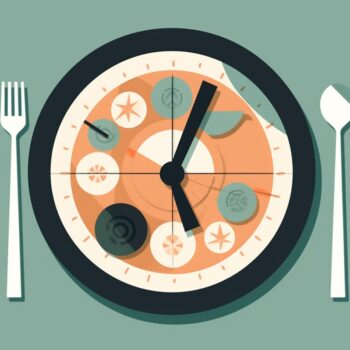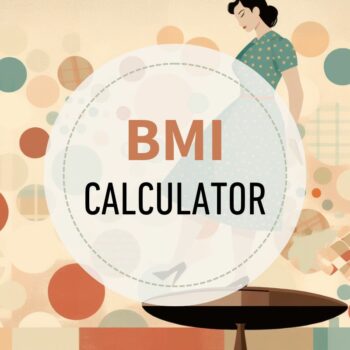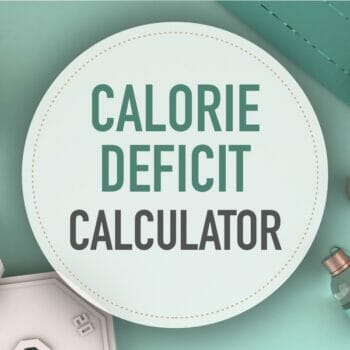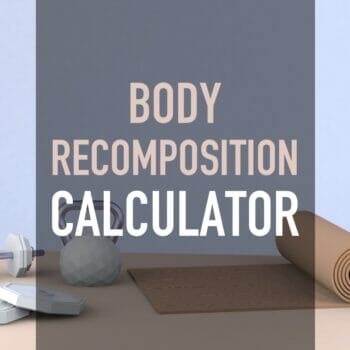Macro Calculator
This free, easy-to-use macro calculator gives you your optimal macronutrients and calories. It’s a weight loss or muscle gain calculator for both women and men.
Combine with macro counting or flexible dieting to reach your goals faster.
How to get leaner and stronger?
Our comprehensive macro-based fat loss program shows you how. Learn more
How do macros work?
The foods we eat are made up of three macros (macronutrients). These are carbohydrates (carbs), protein, and fat.
Chicken is high in protein but has no carbs; rice is high in carbs but has very little fat or protein. The three macronutrients provide the body with energy and raw materials for growth and repair.
By calculating the appropriate daily calorie amount for you, we can then break this down into the best macronutrient ratios to achieve weight loss.
Basic steps for macro counting
- Enter details into the calculator
Make sure to choose the correct goal. - Take note of your calories and macros
These will be the targets you are aiming for each day. - Track your macros
Use an app or pre-plan your meals. - Measure results
Don’t use basic weight scales.
Use proper body composition scales (we recommend Renpho) to measure fat and muscle mass changes.
What is a good macro ratio for fat loss or muscle gain?
Your macros should be based on your Total Daily Energy Expenditure (TDEE) and goals.
The calculator defaults to the best macro ratio proven to work for most people.
This ratio is:
- 30% fat
- Protein is 0.65 grams per pound of body weight,
- The remainder is carbs.
Depending on your goal, this will be either a calorie deficit or a surplus.
You can go further and make more adjustments: Perhaps you’re an extreme endomorph and do better with fewer carbs. Or perhaps you have one kidney and need to eat less protein.
You can fine-tune your results with a bit of math. See how to change your macros here.
What is a good protein ratio?
Rather than a percentage, proteins are based on your body weight. Our calculator has three settings:
- Moderate adjusts the ratio to 0.65 grams per pound of body weight.
This is appropriate for sedentary individuals or people with higher body fat percentages. - High is for active people with moderate strength training and an average body fat percentage.
- Maximum will set the ratio to 1 gram per pound.
This amount is good for bodybuilding and gaining muscle mass. You must be doing intense training.
Find out how to fine-tune your protein ratios when counting macros
Fat macro ratio
Set fat at 30% of daily energy expenditure.
Most people do very well with this amount of fat. See more about choosing the best macro fats. Because of high-fat diets like keto, many people are now eating more fat than they need to.
Carbohydrate macro ratio
Once you’ve calculated protein and fat, the remainder of your daily calories should be from carbohydrates.
Carbs fuel your body and workouts – and are the body’s preferred energy source.
If you are coming from a low-carb background, this may seem high. However, according to respected nutritional research, this is a moderate amount of carbs.
If you are eating according to your TDEE, the notion that carbs cause weight gain or stop fat loss is incorrect.
Using as a Calorie Deficit Calculator
As a weight loss calculator, this tool establishes a safe calorie deficit only.
The Lose option puts you in a 20% calorie deficit, promoting safe, steady weight loss.
The best macro ratio for body recomposition
If you want to recompose your body (lose fat and gain muscle simultaneously), then use the body recomposition calculator.
Macro ratio for maintenance
The Maintain button shows you the macro levels to maintain your current weight.
This is great if you have lost weight and don’t want to gain it back.
Macro ratio for muscle gain
The Gain button puts you in a 20% calorie surplus.
The macro breakdown is designed to build muscle fast in conjunction and must be combined with a comprehensive weight training program.
Underweight people can also use it.
TIP: Try starting with the maintenance goal and gradually increasing calories if you want lean muscle gains.
Calculating macros using your body fat percentage
The calculator uses your body weight to determine calories and macros.
However, you can obtain superior results by using your body fat percentage. The calculator allows you to choose which method: Normal for body weight, Lean Mass for fat percentage.
When to choose the Lean Mass Formula
If you are lean (have a low body fat percentage), choose the Lean Mass formula and enter your body fat %.
If you are classified as obese and have a lot of weight to lose, the lean mass formula is superior. You can read more about macro counting and obesity.
Help? Calculate your ideal body weight or get an assessment of your body fat percentage.
Why the difference? Muscle cells burn more calories than fat cells, so the more accurately we measure this, the better your results will be.
How to calculate macros per meal
You can break this down into meals once you’ve calculated your daily macros in the calculator.
Choose from 2 to 6 meals daily to see the macro ratio you can track for each meal. For some people, this is easier, but for others, this is too much detail.
Do what works for you.
Meal Plans
See a 5-day macro-based meal plan. It includes three meals and two snacks per day.
Macro calculator activity level settings
A higher activity level means a higher daily calorie goal.
For example – if you maintain your weight at 2,000 calories per day, adding vigorous daily exercise means you need more calories to maintain your weight.
If you are sedentary and trying to lose weight, adding exercise will increase your daily calorie goal.
The idea seems counter-intuitive, but more energy is required to fuel your workouts. More workouts lead to increasing metabolism; therefore, more fat is burned!
Undereating is one of the leading causes of the weight loss plateau.
So many of our clients previously “hit the wall” with dieting. They would continually reduce calories, stop losing fat, and gain weight when they eat a little more.
Macro counting defeats this by prescribing the right food and calorie levels.
Which activity level do I choose?
- Sedentary: Just regular everyday activity like a bit of walking, a couple of flights of stairs, eating, etc.
- Light: Any activity that burns 200-400 calories (females) or 250-500 calories (males) over your sedentary amount.
- Moderate: Any activity that burns 400-650 calories (females) or 500-800 calories (males) more than your sedentary amount.
- Extreme: Any activity that burns more than 650 calories (females) or more than 800 calories (males) in addition to your sedentary amount.
Other options for determining your calorie burn
- Use our calories burned calculator – it accurately assesses over 380 activities.
- Use a fitness tracker – like a Fitbit or Apple Watch (note that they can overestimate calorie burn).
- Use a suitable app – like MapMyFitness
Why should I eat more when I exercise more?
High physical activity not fueled with enough calories will lead to muscle catabolism (breakdown of muscle fiber).
This lack of nutrition could stall your weight loss, so eat up if you love to exercise!
I’ve got my macros – now what?
Once you’ve identified your target daily macros, you must determine the macros in all your foods.
By tracking them daily, you can reach your recommended macro targets that encourage fat loss, muscle gain, or whatever your goal may be.
You can learn more about the macro counting system and the flexible dieting philosophy. Many people use an app like Myfitnesspal to track macros.
For more specifics on what to eat – see a sample macro meal plan or a list of macros for familiar foods.
View article sourcesSources
- Mifflin, M. D., St Jeor, S. T., Hill, L. A., Scott, B. J., Daugherty, S. A., & Koh, Y. O. (1990). A new predictive equation for resting energy expenditure in healthy individuals. The American Journal of Clinical Nutrition, 51 (2), 241-247. Link
- McArdle, W. D., Katch, F. I., & Katch, V. L. (2010). Exercise physiology: nutrition, energy, and human performance. Lippincott Williams & Wilkins. Link
- Jequier, E. (1994). Carbohydrates as a source of energy. The American journal of clinical nutrition, 59(3), 682S-685S.
- Lemon, P. W., Tarnopolsky, M. A., MacDougall, J. D., & Atkinson, S. A. (1992). Protein requirements and muscle mass/strength changes during intensive training in novice bodybuilders. Journal of Applied Physiology, 73(2), 767-775. study abstract link
- Grundy, S. M. (1999). The optimal ratio of fat-to-carbohydrate in the diet. Annual review of nutrition, 19(1), 325-341. abstract
- Conlin, L.A., Aguilar, D.T., Rogers, G.E. et al. Flexible vs. rigid dieting in resistance-trained individuals seeking to optimize their physiques: A randomized controlled trial. J Int Soc Sports Nutr 18, 52 (2021). https://doi.org/10.1186/s12970-021-00452-2
2,104 Comments


 Menopause Macro Calculator
Menopause Macro Calculator Intermittent Fasting Calculator
Intermittent Fasting Calculator BMI Calculator
BMI Calculator Calorie Deficit Calculator
Calorie Deficit Calculator Body Recomposition Calculator
Body Recomposition Calculator
Hi Ted… Just a quick question – I have a TDEE of 2100
Im in my 60’s – VERY ACTIVE- do a few workouts each day, including walking 2-3 miles daily…
I feel like Im stuck— weight is 190 (have had some success with Lindora) but, feel with macro nutrients I can do this on my own…
If my goal loss is 2 lbs. a week (my goal weight is 145 lbs. by Nov.)
What would my macro %% be daily??
Thank you
Hi Julie, Your macro percentages don’t determine weight loss but the correct weight-loss TDEE does. This should be a deficit that is safe and produces about 1 pound per week of weight loss. 2 pounds per week isn’t sustainable or realistic. I’d be happy to calculate everything for you and get you on a healthy track. See my coaching options and I have an affordable “calculations only” option.
Calculator gave me:
1520 CALORIES PER DAY
Carb 130g34.1%
Protein 137g35.9%
Fat 51g30.0%
But I do
Calories 1100-1300 (1 major Cheat day of approx 2400)
Carb 100ish
Protein 90-100
Fat 30-35
Some say this is low but I live a very sedentary life and this seems to work for me. DO you have any suggestions?
Hi Jennifer, It seems a bit low to me too and if you have too many of those cheat days you could be also slowing your progress. However, I can’t really say for sure because I don’t know your stats or much about your lifestyle.
I started tracking macros a few weeks ago. I am very consistent and weigh my food etc and track in my fitness pal. I haven’t really lost much weight…maybe 1-1.5 lbs. I noticed your calculator has me at a lower calorie intake than the other online one I used. What am I doing wrong and why am I not losing any weight?
Hi Stacey, It’s important to understand that all calculators give you an “estimation” and use different formulas to do so. This often needs tweaked as you implement. If you aren’t losing about a pound a week then you should go a little lower.
Hi! I’m 39 and weigh 70kg, 5ft 5. I have been working out 2-3 times a week (strength), walking 10-14k steps per day and eating 1700 cals a day for the past 5 weeks. I have managed to lose half a kg. What am I doing wrong? Also, I am scheduled for surgery which will mean no activity for a few weeks. Should I drop everything down to sedentary level? Thanks
Hi Carla, There could be a couple of things like how had you been eating prior and how long and intense your strength training workouts are but it does sound like an energy balance issue. On days you don’t or can’t workout you should eat at sedentary levels. So this would be your goal during your recovery.
Hi Ted, I am 52 and in menopause. 5’4 and weigh 66kg. Never had to worry about my weight but now find myself working harder to lose the weight . Been counting macros and walking for an hour a day but nothing seems to be happening. Am eating 1000-1200 calories which should have me in a deficit. What am I doing wrong
Hi Pan, You’re not eating enough. 1000-1200 calories is too restrictive on days you walk for an hour. Be good to your body and it will be good to you.
I’m struggling with my eating plan.
I’ve been aiming for the recommended 30g of fibre per day and 60g of protein, but to do this my calorie intake is barely over 1200.
I’ve been told that too much fibre hinders nutrient absorption. If I eat meals for calories, my fibre intake reaches between 50g and 60g, which seems really high.
Does anyone have any ideas?
Hi Wonky,
Are you calculating things properly? If you’re eating that much fiber than you’ll need to eat more digestible carbs to compensate. Your protein seems low too.
Can I adjust the carbs lower like you can do with the protein or will it alway automatically fill it in? Can I adjust the fat higher? Is it only the protein that I can adjust? How much does your meal plans cost or are they part of the app? How much is the app?
Hi Zsa, You can manually adjust your ratios but I’d advise against setting your carbs too low. The beauty of macro-based dieting is the balance. I have self-guided plans with some meal plans here The Macro Solution and offer coaching services here Personalized Macros Coaching which is all your optimal calculations and access to my exclusive meal plan database.
Hi Ted,
If the calculator is giving you a much higher number than what you’ve been doing up until now, do you recommend going for it or doing a reverse diet?
I have been eating around 1600 -1700 calories daily with one day where ill have alcohol and an untracked meal. Lift 60 min 5x week, two 40 min spin classes/week plus a long run. My fit bit always has me burning 2-2500 cals/day
Im always hungry and clearly my metabolism is shot, I lost ten pounds doing 1500 calories per day but wasnt sustainable. Im 5’7″ 31yoF and 155 lbs. Is a reverse diet necessary or could I just start out with the near 1900 cals/day recommended by the app and track alcohol .
Thanks!
Hi Cara, So glad you are seeing the need to be eating more. Most people can fix things by just increasing to a 20% deficit which is what the calculator is giving you. Start there and see how your body starts responding.
I’m a runner and run anything from 16km to 25km 5 days a week. What would I consider for my rest days. I’m not wanting to lose weight. Goal is to maintain
I should add that I’m 35 and 50kg
Hi Renee, For runners, it’s better to track your run and then add your run’s calorie burn to your sedentary calculation. Cap your protein at 120 g then do 30% fat and the rest carbs.
So I work out 3 days a week . Burn 500 calories, and the rest if the days should be sedentary, do I still cut 20% on rest days
Hi James, If your goal is fat loss then yes, keep your deficit consistent as many days of the week as you can.
Thanks 1 more question since I have 34% bodyfat 208 pounds 5ft 5in, 3 Dat strength training do I eat moderate protien or high
You could actually get away with normal protein since your fat tissue will skew the calculation. I would think you wouldn’t need any more than 160 g per day max.
Hey man.
I’m 20 years old, 6 ft 2 and weigh around 220lbs. I’m looking to remove the last layer of bodyfat and i have no ideas about how i’m supposed to eat for that. I eat pretty healthy and i work out about 4-6 days a week. I just now started working on removing the last fat layer. I’m i right in eating mostly protein, a regular amount of carbs and kinda limit the fat? Thanks anyways 👍
Hi Mathias, Good for you! It’s actually about energy balance. I recommend maintaining a 20% calorie deficit on both your training and workout days. The high setting for protein is fine and fats should be around 25-30%. Eating fat doesn’t prevent you from losing fat, nor does eating carbs. These two macros are the easiest to overeat which is why they get a bad rap. Eating them in relation to your weight loss TDEE is key.
Hi Ted,
i am 29 years old, 181cm and weigh 81kg and train 5-6 times per week (TDEE 3000). I wish to gain muscle mass which i believe is around 3300 calories for me personally. I am confused about my recommended grams of macros compared to the standard ratios.
I am to the understanding that an est. of 45% Carbs, 35% proteins and 20% fats (give or take) is what you should be after.
However at 2g of protein per kilo (162g*4cals=648cals) is only 20% of my 3300 calorie requirement. if 20% fat is to be 74g*9cals=666cals this means my carbs are a really high at 60% or 496g*4cals to hit the remaining 1986cals
Should I be having more protein is is this 60 / 20 / 20 ratio okay?
Thanks
Sean
Hi Sean, I think you’ve figured it out. You have to cap your protein since you’re lean and workouts are intense, otherwise, you’ll be eating too much and just be burning extra as energy. Probably a cap of 170 g would be fine. Your fat can be around 25-30% and the rest can be carbs.